Luteonectria Sand.-Den., L. Lombard, Schroers & Rossman, gen. nov. Figs 8, 30.
MycoBank number: MB 838664; Index Fungorum number: IF 838664; Facesoffungi number: FoF 10966;
Etymology: Name refers to the luteous coloured, nectria-like ascomata characteristic of these fungi.
Type species: Luteonectria albida (Rossman) Sand.-Den. & L. Lombard
Ascomata perithecial, gregarious on a well-developed stroma composed of pseudoparenchymatous cells, covered with loose, white hyphae, smooth and thin-walled, globose to pyriform, off- white to pale luteous, becoming ochraceous when dry, with a broadly rounded and papillate apical region, not changing colour in KOH or lactic acid, short setae-like hairs sometimes emerging from perithecial wall. Asci clavate with simple apex, 8-spored, ascospores overlapping irregularly uniseriate to biseriate. Ascospores fusiform with rounded ends, 3-septate, slightly con-stricted at septum, hyaline, becoming pale yellow-brown, smooth-walled to finely striate. Conidiophores mononematous, septate and irregularly branched, bearing terminal phialides. Conidiogenous cells monophialidic, cylindrical to subcylindrical, smooth- and thin-walled, with periclinal thickening inconspicuous to absent. Macroconidia fusoid and multiseptate, 1– 7-septate, curved, hyaline, with a wide, blunt apical cell and a poorly- to well-developed, foot-shaped basal cell. Micro– and mesoconidia unknown. Chlamydospores unknown. [Description adapted from Rossman (1983) and Schroers et al.(2011)].
Diagnostic features: Off-white to pale luteous perithecia that do not change colour on KOH or lactic acid, formed on well- developed stroma producing clavate asci containing fusiform, 3- septate, finely striate ascospores and fusarioid asexual morph characterised by monophialides producing robust multiseptate conidia from aerial conidiophores, lacking micro- and meso- conidia, and chlamydospores.
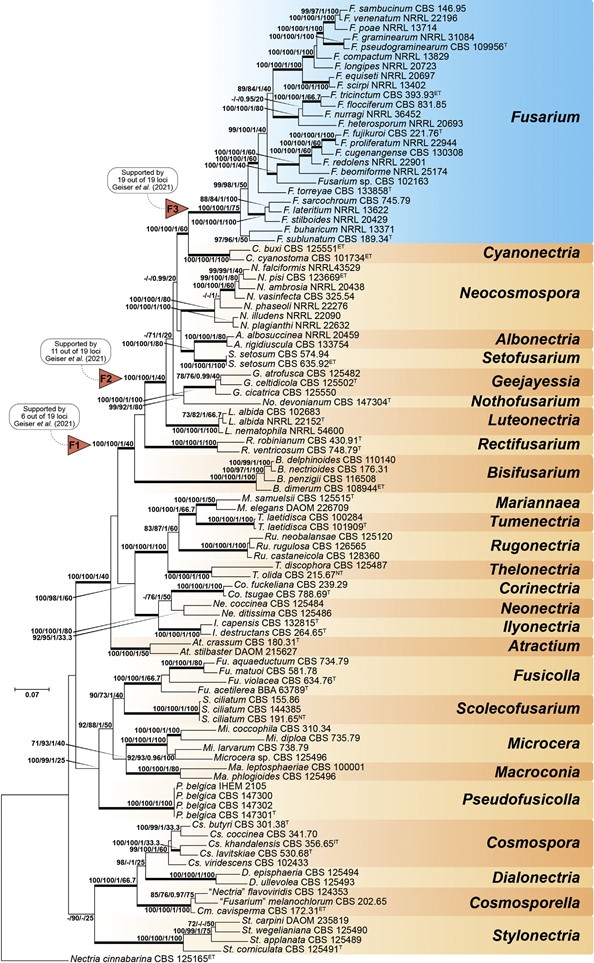
Fig. 7. Maximum-Likelihood (IQ-TREE-ML) consensus tree inferred from the combined ITS, LSU, rpb1, rpb2 and tef1 multiple sequence alignment of members of Nectriaceae. Numbers at the branches indicate support values (RAxML-BS / UFboot2-BS / BI-PP / gCF) above 70 % / 0.95 with thickened branches indicating full support (RAxML-BS / UFboot2-BS / gCF = 100 %; BI-PP = 1). The scale bar indicates expected changes per site. The tree is rooted to Nectria cinnabarina (CBS 125165). Arrows “F1”, “F2” and “F3” indicate the three alternative Fusarium hypotheses sensu Geiser et al. (2013). Ex-epitype, ex-isotype, ex-neotype and ex-type strains are indicated with ET, IT, NT, and T, respectively.
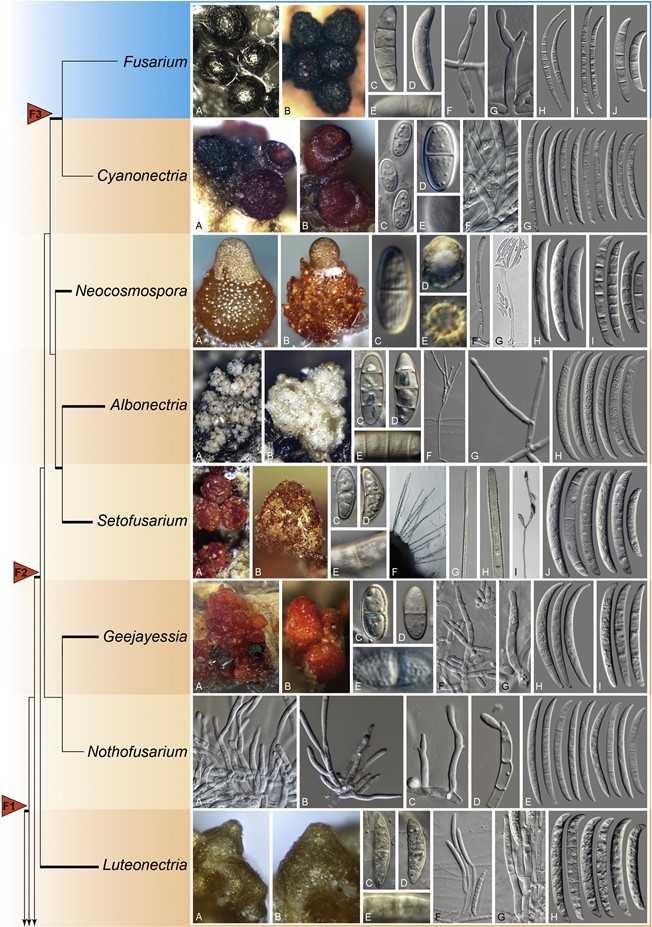
Fig. 8. (Continued).
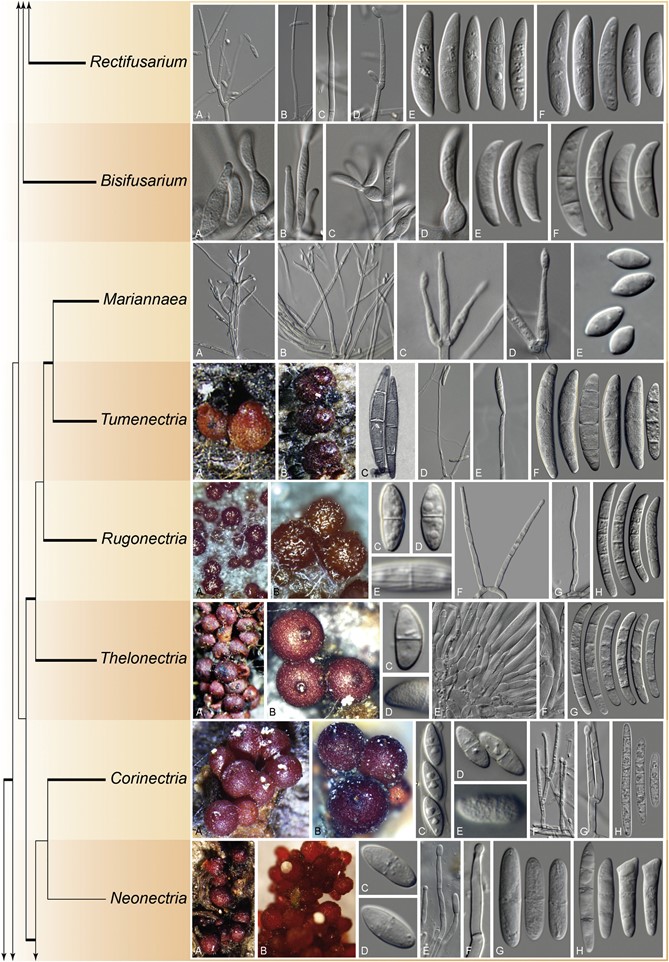
Fig. 8. (Continued).
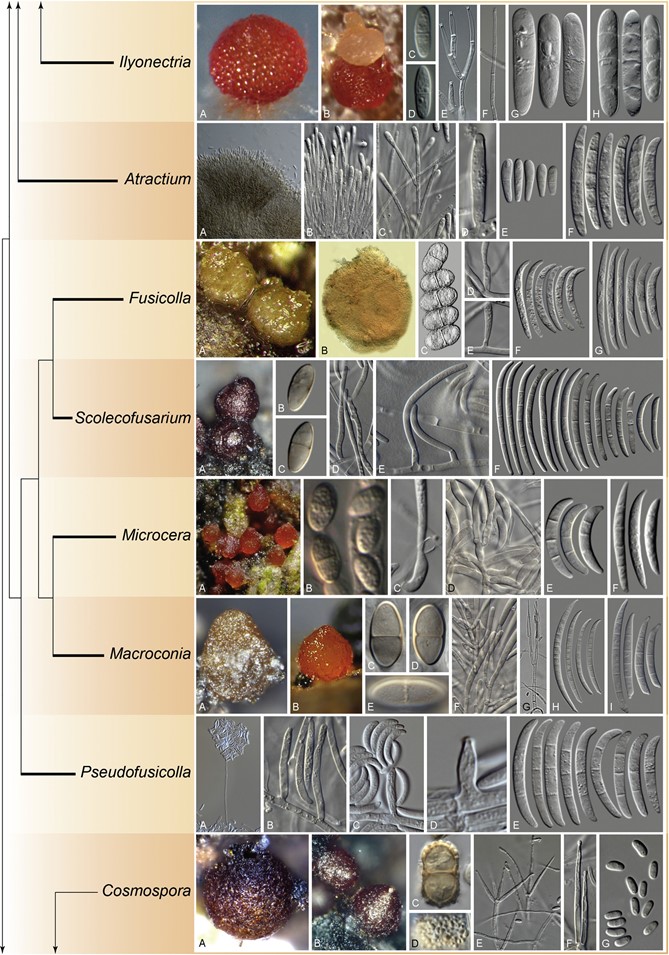
Fig. 8. (Continued).
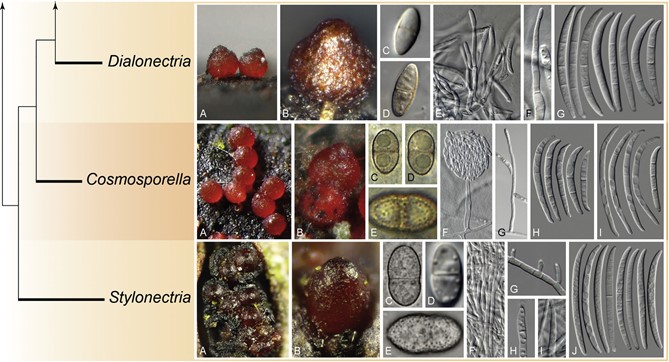
Fig. 8. Morphological features and phylogenetic affinities of fusarioid genera of Nectriaceae and close relatives. The tree was delineated based on the phylogeny presented in Fig. 7 and does not indicate phylogenetic distances. Fully supported branches are indicated in bold. The genus Fusarium is indicated in blue. Arrows “F1”, “F2” and “F3” indicate the three alternative Fusarium hypotheses sensu Geiser et al. (2013). Fusarium. A, B. Ascomata. C– E. Ascospores. F, G. Conidiogenous cells. H– J. Macroconidia. (B. Adapted from Schroers et al. 2011). Cyanonectria. A, B. Ascomata. C–E. Ascospores. F. Conidiogenous cells. G. Macroconidia. Neocosmospora. A, B. Ascomata. C–E. Ascospores. F, G. Conidiogenous cells. H, I. Macroconidia. [A. Adapted from Sandoval-Denis & Crous (2018). G. Adapted from Sandoval-Denis et al. (2019)]. Albonectria. A, B. Ascomata. C–E. Ascospores. F, G. Conidiophores and conidiogenous cells. H. Macroconidia. Setofusarium. A, B. Ascomata. C–E. Ascospores. F– H. Setae formed on sporodochia. I. Conidiophore. J. Conidia. Geejayessia. A, B. Ascomata. C–E. Ascospores. F, G. Conidiophores and conidiogenous cells. H, I. Macroconidia. [A. Adapted from Schroers et al. (2011)]. Nothofusarium. A–D. Conidiophores and conidiogenous cells. E. Conidia. Luteonectria. A, B. Ascomata. C– D. Ascospores. F, G. Conidiophores and conidiogenous cells. H. Conidia. Rectifusarium. A– D. Conidiophores and conidiogenous cells. E, F. Conidia. Bisifusarium. A– D. Conidiophores and conidiogenous cells. E, F. Conidia. Mariannaea. A, B. Conidiophores. C, D. Conidiogenous cells. E. Conidia. Tumenectria. A, B. Ascomata. C. Ascospores. D, E. Conidiophores and conidiogenous cells. F. Conidia. [A– C. Adapted from Salgado-Salazar et al. (2016)]. Rugonectria. A, B. Ascomata. C– E. Ascospores. F, G. Conidiophores and conidiogenous cells. H. Conidia. Thelonectria. A, B. Ascomata. C, D. Ascospores. E, F. Conidiophores and conidiogenous cells. G. Conidia. Corinectria. A, B. Ascomata. C– E. Ascospores. F, G. Conidiophores and conidiogenous cells. H. Conidia. (H. Picture by C. Gonz´alez). Neonectria. A, B. Ascomata. C, D. Ascospores. E, F. Conidiophores and conidiogenous cells. G, H. Conidia. [A. Adapted from Chaverri et al. (2011)]. Ilyonectria. A, B. Ascomata. C, D. Ascospores. E, F. Conidiophores and conidiogenous cells. G, H. Conidia. Atractium. A, B. Conidiophores. C, D. Conidiogenous cells. E, F. Conidia. Fusicolla. A, B. Ascomata. C. Ascospores. D, E. Conidiogenous cells. F, G. Conidia. (A–C. Pictures by C. Lechat). Scolecofusarium. A. Ascomata. B, C. Ascospores. D, E. Conidiophores and conidiogenous cells. F. Conidia. Microcera. A. Ascomata. B. Ascospores. C, D. Conidiogenous cells. E, F. Conidia. (A, B. Pictures by N. Aplin, Fungi of Great Britain and Ireland). Macroconia. A, B. Ascomata. C–E. Ascospores. F, G. Conidiophores and conidiogenous cells. H, I. Conidia. (B. Picture by P. Mlˇcoch). Pseudofusicolla. A, B. Conidiophores and conidiogenous cells. C, D. Conidia. [A– D. Adapted from Triest et al. (2016)]. Cosmospora. A, B. Ascomata. C, D. Ascospores. E, F. Conidiophores and conidiogenous cells. G. Conidia. Dialonectria. A, B. Ascomata. C– E. Ascospores. F, G. Conidiophores and conidiogenous cells. H. Conidia. (A. Picture by P. Mlˇcoch). Cosmosporella. A, B. Ascomata. C–E. Ascospores. F, G. Conidiophores and con- idiogenous cells. H, I. Conidia. (A–E. Pictures by P. Mlˇcoch). Stylonectria. A, B. Ascomata. C– E. Ascospores. F– I. Conidiophores and conidiogenous cells. J. Conidia. (A–C, E. Pictures by B. Wergen).

Fig. 30. Luteonectria albida. A–C. Ascomata on natural substrate. D. Surface view of perithecial wall in lactic acid. E. Detail of ascomata hair. F. Asci. G–J. Ascospores (J. Surface view). K, L. Conidiophores and conidiogenous cells. M. Macroconidia. A, C. BPI 550103. B. BPI 1108874. D– J. BPI 1108875. K–M. CBS 102683. Scale bars: A, B = 100 μm; C = 50 μm; all others = 10 μm.
Species
